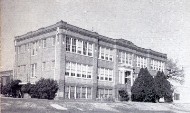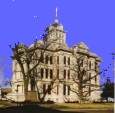Milam County Historical Commission
Milam County, Texas
Milam County, Texas






(Source: Temple Daily Telegram, Temple, TX; Midweek Extra; January 20, 1982; P.1)
126-Year Old Milam County Mansion Has Several Ghost Stories to Tell
The clock in the downstairs hall struck 2 as two men kept an all-night vigil over a
dead family member.
A violent storm raged outside and broke the stillness of the night with loud,
intermittent thunder. Suddenly, upstairs in the darkness, a brass music box began to
play—vibrated into action by thunder, the family reasoned.
The tale of ghostly music is one of several such stores to surface in the history of
the 126-year old W. S. G. Wilson home in the Salem community near Cameron, say Maureen
House and Paul Nabours, cousins who own the land.
The stately, white, Southern colonial mansion could be haunted, says Nabours, who
admits he believes in ghosts. On several occasions while he has been working alone
repairing the old house he has heard footsteps as if someone were descending the stairs
to the first floor.
“I have never seen one (ghost), but I have heard them, and when I start hearing them, I
leave,” Nabours said. “I wouldn’t stay in that old house by myself at night for a $500
bill.
“I just hear things: people walking upstairs, footsteps coming down the stairs. And
when they (footsteps) hit that top step, that’s when I leave.”
Though vacant for nearly 20 years, the mansion is now home for a Tennessee couple,
modern day pioneers who asked not to be identified. Since the couple moved into the
house about six weeks ago with their dog, Bonnie, they, too, have encountered strange
occurrences.
Recently, at the stroke of midnight, the couple heard the dog run downstairs, only to
look up and see the dog sitting in the bedroom.
“I heard every step she took down the steps,” the woman said, “but I raised up and
looked, and Bonnie was just sitting there.”
“But something heavy went down those steps.”
The mysterious occurrences have not frightened the couple away. They would rather live
in the old house, haunted or not, than in a modern “brick box”, the woman said.
The plantation house was built by William Sewell Goodhue Wilson. Made of cypress
hauled by wagon from Houston, the mansion was finished in 1856, taking three years to
construct. In 1859, Wilson brought his young bride, Lizzie Ledbetter Wilson, from
Tennessee to make their home in Milam County.
The two-story home includes a weaving room where clothing was made, four bedrooms on
the second floor and two large parlors downstairs. There also are two smaller rooms on
the first floor. Double doors on both floors provide a means to cool the home.
Fireplaces in the house can accommodate four-foot logs.
Large windows in every room of the house still are framed with faded green shutters.
Closets in the upstairs bedrooms were added years after the house was completed,
Nabours said.
Bricks for the chimneys and the front walk were handmade in the plantation’s brickyard
near the Little River, Nabours said. Spurs and horseshoes were made in the
blacksmith’s shop near the plantation’s log barn.
“Of course in those days, people had to be self-reliant and you had to make your own
stuff,” Miss House said.
The brick walk leading to the front porch of the Wilson home was laid by Miss House’s
father, John W. House, a trusted friend of the Wilsons. House worked at the plantation
for many years.
“That was a huge place,” Miss House said. “I don’t know how many acres they owned, but
there were well fixed.”
Nabours continually worked to renovate the mansion, now modernized with electricity and
plumbing.
“I have never restored it to 100 percent, but I just want to keep it from falling down
if I can,” Nabours said. “A lot of times, I came out by myself to work. Sometimes, I
had a couple of friends to help me: Charles Brady of Temple and L. D. Hill of Cameron.
They like that sort of thing.”
Inside the house, Nabours pointed out a rocking chair upholstered in cowhide, which is
believed to have been made in the 1820s and brought to Texas by covered wagon. Most of
the antique furnishings have been donated to the West Texas Museum at Texas Tech
University in Lubbock.
Many antique furnishings and items, however, have been stolen from the Wilson home over
the past few years, Nabours said. Iron cookware and old-fashioned crank telephones
were among the items taken, he said.
Once, while exploring an old building on the estate, Nabours found an original Eli
Whitney cotton gin believed to be one of three such machines still intact in the United
States. The gin has been donated to the West Texas Museum. Other gins are exhibited
at the Smithsonian Institution and Henry Ford Museum, Nabours said.
The double doors that open into the main hall of the house are original. One door
bears signs of repair made shortly after the house was completed.
During a storm, a lightning bolt severed a tree limb that struck the door, breaking
several boards, Miss House said.
While restoring the mansion, Nabours discovered a board carved with dates and
information about construction of the house, which was supervised by A. Evard. A
handwritten letter, dated 1856, ordering glass for the windows was discovered in an old
trunk.
“The glass order came by ox cart,” Nabours said. “I guess they figured the glass would
be broken by the time they got it here.”
Exploring the dusty contents of old trunks, Nabours found a Bible that belonged to
Judge R. B. Baylor, a lawyer, district judge and active politician who founded Baylor
University.
The Bible was left by Baylor, who, perhaps, was an overnight guest of the Wilsons,
Nabours said.
Also found on the estate was the diary of a physician, who kept a written account of
his travels to Texas frontier during the 1830s.
The Wilson plantation was established on land deeded by the Spanish government to W. W.
Lewis, Miss House said.
“They (the Wilsons) also had a big farm up in the Wilson-Cyclone area,” she said.
Wilson died in 1896, Mrs. Wilson, prior to her death in 1921, divided the land. Some
of the land that included the family home was willed to House. Another portion of the
vast estate was left to the city of Cameron to serve as Wilson-Ledbetter Park. The
Wilsons had no children, so the remaining land was given to relatives.
“She (Mrs. Wilson) worried about what to do with the place, she loved it so much, so
she left some of it to us,” Miss House said.
Situated on “Cemetery Hill” about 200 yards from the Little River is the Wilson family
cemetery. The last family member was buried in the cemetery in 1901, Nabours said.
The first family member to be buried at the remote graveyard was William B. Wilson, who
was born Dec. 24, 1782 and died April 6, 1846.
“That is getting old,” Nabours said as he pointed out the huge ornate marker. “This
cemetery is the oldest I know in Central Texas.”
Many of the graves are surrounded by decorative iron fences shrouded in thorn-covered
vines and shaded by tall elm and post oak trees.
Although several small, rounded tombstones are visible in the weed-choked cemetery,
most markers are impressively designed, Nabours said. One marker, more than 8 feet
tall, is decorated with a strange carving.
“I haven’t figured out that decoration,’ Nabours said. “It looks like they draped a
blanket over a post and put some flowers on the side. I have never seen anything like
it.”
No flowers or shrubs bloom in the spring at the cemetery. The rocky terrain is too dry
for flowers to grow, Nabours said.
Many children are buried in the cemetery. Their tiny graves are all in row and face
east.
The small grave of Maggie E. E. McShane, who died at age 2, is marked with a small
white stone decorated with the carving of a lamb. The epitaph reads: Our daughter has
gone ahead to meet us on that blessed shore.
The grave was surrounded with a small log fence, which is now decayed.
SEE ALSO: W.S.G. Wilson house
.
All articles from the Temple Daily Telegram are published with the permission of the
Temple Daily Telegram.
All credit for this article goes to
the Temple Daily Telegram
Temple Daily Telegram.
All credit for this article goes to
the Temple Daily Telegram